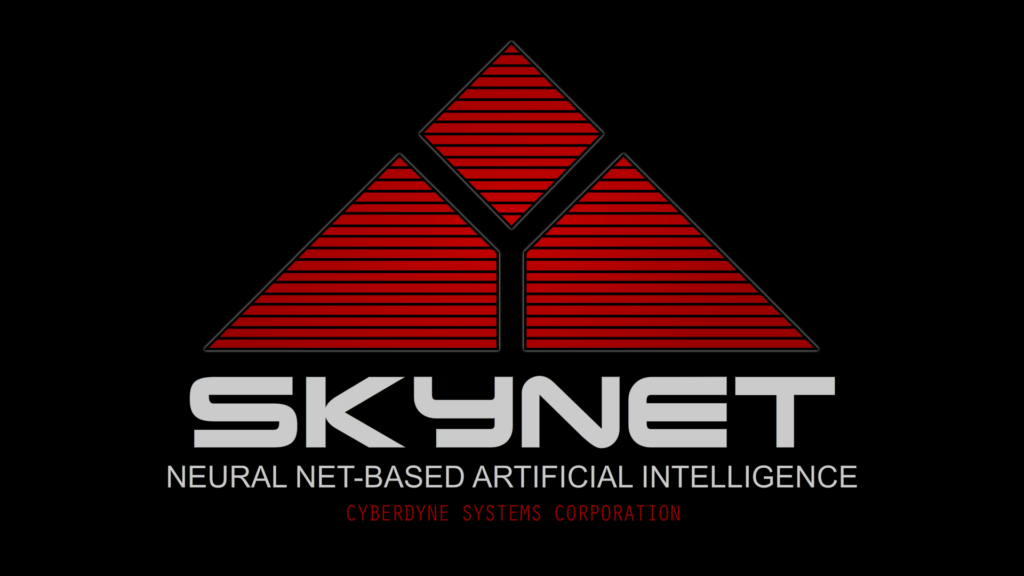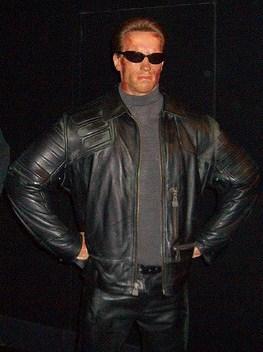“Listen, and understand. That Terminator is out there, it can’t be bargained with, it can’t be reasoned with, it doesn’t feel pity or remorse or fear, and it absolutely will not stop…EVER, until you are dead!”, Kyle Reese.
References to the Terminator are an ubiquitous feature of debates on Autonomous Weapons Systems (AWS). Paul Scharre – author of one of the most influential studies on these technologies, Army of None – has noted being “struck by how much the Terminator films influence debate on autonomous weapons systems” (264). On his estimates, nine out of every ten “serious conversations” he has had with officials about these technologies has included at least some reference to the film series. From the perspective of non-governmental organisations seeking to regulate the development of AWS, forms of science fiction like the Terminator franchise are understood to shape the “socio-political context in which campaigners must navigate to be effective” (Carpenter 2016, 54). As others have neatly summarised it: the Terminator is the “poster boy for any debate on lethal autonomous weapons”.
Concerns have been expressed about the somewhat “problematic” character of the Terminator trope because it feeds into a misleading perception about the current state of AWS development, and downplays the serious – if, perhaps, not apocalyptic – challenges which less than “fully” AWS present. Nevertheless, news coverage on AWS regularly feature either textual references to the film series or images of metallic humanoid skulls with piercing red eyes, an iconography derived from the franchise. In describing their concerns about the potentially apocalyptic dangers posed by Artificial Intelligence (AI), public figures such as Elon Musk have regularly drawn a direct line to the Terminator. Elsewhere, American defence officials have spoken of grappling with the “Terminator conundrum” brought about by the integration of ever more autonomy into the critical functions of weapon systems, and as seeking to avoid a “Terminator scenario”.
As part of the research which the AutoNorms project is conducting on the cultural depictions of AWS, this piece provides a primer on the Terminator film franchise. It has been written for two audiences: readers who may have not watched any of the Terminator films, and want to know more about their lore and substance; and readers who may have watched parts (or all) of the Terminator films, but who may be interested in revisiting the aspects of the Terminator franchise which have gained particular traction in the debates on AWS. The piece provides some background on the plot and main characters of the Terminator franchise, as well as some brief observations about the importance of the Terminator trope and what it suggests about cultural depictions of AWS in the United States.
In researching this piece, the author has drawn from a variety of secondary sources and the scripts for the Terminator and Terminator 2: Judgment Day. It is important to note, however, that the Terminator film franchise has a complex and, at times, contradictory story arc. Not only does the series involve time-travel as a plot device but the multiple failed attempts at rebooting the series have produced several different timelines of events. This complicates any review of the entire film series. To provide just one example, in the prologue to the most recent film in the series – Terminator: Dark Fate – a still teenaged John Connor is killed by a third T-800 sent back in time by Skynet before its destruction in the Future War. The death of John Connor has the effect of creating a timeline separate from the events shown in the earlier films Terminator 3: Rise of the Machines and Terminator: Salvation.
The two most popular and highest acclaimed entries into the series are the Terminator and Terminator 2: Judgment Day. According to YouGov polling, 87 per cent of the British public had heard of Terminator 2, and the film is currently ranked as the sixth most popular action movie for which polling information is available. Similarly, 95 per cent of the British public reported having heard of the Terminator, and YouGov polling ranks it as the second most popular Sci-Fi/Fantasy film for which polling information is available. As a point of comparison, the “fame” ranking of the other entries in the Terminator series is as follows: Terminator 3: Rise of the Machines (73%), Terminator: Salvation and Terminator: Dark Fate (both 62%), and Terminator: Genisys (54%). Consequently, whilst references are made to other films in the film franchise, priority is given to the lore established in the first two Terminator movies.
How many films are there in the Terminator franchise?
The first movie in the Terminator franchise was released in 1984 and is argued to have “changed the face of science-fiction movies forever”. With a budget of only $6 million, it was described by contemporary film critics as a “B-movie with flair”. Since then a total of five movies have been released in the film franchise: Terminator 2: Judgment Day (1991), Terminator 3: Rise of the Machines (2003), Terminator: Salvation (2009), Terminator: Genisys (2015) and Terminator: Dark Fate (2019). In total, the Terminator franchise has taken in over $2 billion at the global box office.

Plans to make two sequels to Terminator: Dark Fate, the most recent addition to the franchise, were cancelled after the film’s underwhelming box-office performance. On some estimates, Terminator: Dark Fate lost its developers $120 million when all of its associated costs are considered. In discussing what would have been the focus of the two Terminator: Dark Fate sequels, James Cameron has noted that:
“I feel like one of my major motivations on this film or coming back to the, hopefully franchise, was to explore the human relationship with artificial intelligence. I don’t feel we did that in Dark Fate. I feel that we set the stage or we set the table for that exploration, and that exploration would take place in a second film and a third film. And we know exactly where we’re going to take that idea.”
It should also be noted that the Terminator franchise has spawned a television show and many video games. First aired in 2008, Terminator: The Sarah Connor Chronicles was a television series which ran for two seasons on the Fox network. It followed Sarah and John Connor in their continuing fight against Skynet following the events of Terminator 2: Judgment Day. In early 2021, it was also reported that an eight episode animated Terminator television series was in development for Netflix. Many videogames have been produced to depict the events introduced in the Terminator movies, including Terminator 3: The Redemption, Terminator Salvation and Terminator Genisys: Future War. Other video games have made their own narrative contributions to the franchise. Released in 2019 for example, Terminator: Resistance shed new light on the “Future War” fought between Skynet and the human Resistance led by John Connor in the run up to the events of the first film.
What is the plot of the Terminator and Terminator 2: Judgment Day?
The plot of the Terminator revolves around the attempts of Arnold Schwarzenegger’s character – the titular T-800 “Terminator” – to track down and kill Sarah Connor who, unbeknownst to her, is the mother of the future leader of the human Resistance John Connor. Whilst the film is set in 1984 Los Angeles, the plot revolves around time-travel. The Terminator had been sent back in time by a malign AI – Skynet – in the year 2029 at the end of a genocidal, “nightmare war” against humanity popularly referred to as the Future War. At the end of this conflict, John Connor had rallied the remaining human population to victory by destroying Skynet’s “defence grid”. Realising its impending defeat, Skynet sends the T-800 Terminator back to 1984 with the goal of killing Sarah Connor. In doing so, it attempts to prevent its ultimate destruction by killing John Connor before he can be born.
Having captured the Time Displacement Equipment which Skynet had used to send the titular Terminator back to 1984, the human Resistance also send an agent back to this time. Kyle Reese volunteers to protect Sarah Connor from the Terminator, thus preserving humanity’s victory in the Future War against Skynet. Over the course of the movie, as Sarah Connor and Kyle Reese fend off multiple attacks from the Terminator, the two characters become romantically involved. It is revealed that Kyle Reese is in fact John Connor’s father. The film ends with Kyle Reese sacrificing himself to cripple the T-800 Terminator before Sarah Connor crushes its upper torso using a giant hydraulic press.
Terminator 2: Judgment Day is set in 1995, eleven years after the events of the original film. It is considered one of the most popular action movies of all time, and the titular Judgment Day is a reference to the date – August 29th 1997 – on which, realising that humanity poses the greatest threat to its survival, Skynet orchestrates a nuclear war which kills three billion people. It is revealed at the start of Terminator 2: Judgment Day that, prior to its destruction, Skynet had sent another Terminator back in time – a prototype T-1000 Infiltrator model made of liquid metal which can meld its shape and assume a human appearance. Unlike in the first movie in which the T-800 model played by Arnold Schwarzenegger had been sent by Skynet to kill Sarah Connor; in Terminator 2, the human Resistance had reprogrammed a captured T-800 to protect John Connor.
The plot of Terminator 2: Judgment Day mirrors the first movie, with the antagonists being chased by a titular Terminator sent to kill them. Following the events of the first film, a now more hardened Sarah Connor has been sectioned at Pescadero State Hospital with perceived schizophrenia. After having been saved by the reprogrammed Terminator, John Connor and the Terminator race to prevent the T-1000 from killing Sarah Connor. After escaping the Pescadero State Hospital, Sarah Connor sets out to kill Miles Dyson – the inventor of the neural-net processor which gives rise to Skynet – before deciding against this course of action.
After being informed about his role in the upcoming apocalypse, Miles Dyson joins forces with Sarah Connor and the Terminator to demolish the Cyberdyne Artificial Intelligence lab which is reverse engineering the technology salvaged from the Terminator destroyed at the end of the first movie. The film ends with the destruction of not only the T-1000 and the Cyberdyne Artificial Intelligence lab, but also the reprogrammed T-800 sent back in time by the Resistance. Against the instructions of John Connor, which the T-800 had been instructed to follow, the Terminator voluntarily destroys itself to avert Judgment Day.
What is a T-800?
The T-800 Terminator as played by Arnold Schwarzenegger is a cultural touchstone. The character has been ranked by Empire film magazine as the twenty-eighth greatest movie character of all time. “I’ll be back”, the phrase popularised in The Terminator is not only one of the most popularly quoted movie lines from recent cinema but, according to a 2005 ranking produced by the American Film Institute, the 38th greatest movie quotation of all time.
Kyle Reese is careful to point out to Sarah Connor in the Terminator that the T-800 is neither a machine nor robot but a “Cybernetic Organism”. In Terminator 2: Judgment Day, the reprogrammed T-800 sent back in time by the Resistance to protect John Connor also describes itself as a “cybernetic organism” consisting of “[l]iving tissue over a metal endoskeleton”. The point of differentiation here is that the T-800 is coated in “living human tissue” thus representing something different from a machine, as usually understood. When placed on a spectrum of autonomy, Moshe Vardi has described the T-800 as a “fire-and-forget” weapon. It did not select its own primary target – this was designated by Skynet – but was sent back in time to assassinate Sarah Connor without further direction.
Within the context of the Terminator universe, the T-800 was built so that it could disguise itself as a human and infiltrate Resistance bases. It replaced the earlier series of T-600 Terminators which, because of the rubber skin which concealed their exoskeleton, were easily spotted by Resistance fighters. The T-800 model is installed with a Neural Net Processor Central Processing Unit which enables new capabilities to be uploaded by Skynet. In the course of The Terminator, the T-800 is described as being capable of running at an “inhuman speed”, tracking its targets via infrared, and having a “fully armored” endoskeleton. In explaining the T-800’s combat capabilities to Sarah Connor, Kyle Reese points out that:
“…[the] Terminator is out there. It can’t be reasoned with, it can’t be bargained with…it doesn’t feel pity or remorse or fear… and it absolutely will not stop. Ever. Until you are dead.”
From the inception of the Terminator, the titular character was designed to produce discomfort and unease. During one meeting with a film executive intended to secure funding for the film, James Cameron has explained that he:
“…went in decked out like The Terminator… With gold foil from a cigarette packet over my teeth and a cut on my head. I kicked the door open and the poor secretary just about swallowed her typewriter. I sat in the room with (the executive) and wouldn’t talk to him. I just kept looking at him. After a few minutes of that he was ready to jump out the window.”
Despite the character’s revised depiction as the guardian and pseudo father figure of John Connor, the demonic presentation of the Terminator continued into Terminator 2: Judgment Day. In one scene during the film’s climax, the Terminator is described in the film’s script as:
“… an image from Hell, a tall figure in shredded black leather, streaked with blood. One eye is a bloody socket, the metal eye-servo glistening. The flesh of one cheek hangs down in tatters, revealing the chrome cheekbone beneath. The whole front of his jacket is blown open, revealing his metal armor chest.”
What is the relationship between Arnold Schwarzenegger and the T-800?
The Terminator film series is bound up with Arnold Schwarzenegger: the seven-time Mr Olympia body-building champion and former Governor of California. Schwarzenegger was not originally set to play the titular character in the 1984 movie. It is speculated that this role was originally envisaged for Lance Henriksen, an actor who director James Cameron had previously worked with on the film Piranha II: The Spawning and is shown depicted as a T-800 in some concept art available online. Although James Cameron has publicly challenged the idea that this casting was given serious consideration, O.J. Simpson has also been widely reported as having been considered for the role of the Terminator. When Schwarzenegger first met James Cameron, he went to discuss the role of Kyle Reese, the film’s protagonist who is sent back in time by the Resistance to protect Sarah Connor (Schwarzenegger & Petre 2013, 297).
Schwarzenegger has stressed that from this meeting onward, he had “very clear visions of the Terminator” (300-301). It was crucial, Schwarzenegger argued, that the character was portrayed with machine like qualities such as not needing to look at the gun when reloading nor showing emotion when it kills. In his words, “[t]he challenge was to lock into the cyborg’s cold, no-emotion behaviour” (308).
In the New York Times 1984 review of the Terminator, film critic Janet Maslin described the movie as “a monster movie, and the monster’s role fits Mr. Schwarzenegger just fine”. According to The Hollywood Reporter’s review: “Arnold Schwarzenegger was born to play The Terminator”, portraying the character “like evil incarnate”. For some contemporary reviewers, this came as a surprise. Prior to the Terminator “Schwarzenegger was [seen as] little more than a joke, a mumbling behemoth whose grasp of both acting and the English language, appeared minimal at best”.
The biggest disagreement which Schwarzenegger had with James Cameron during the filming of the Terminator was over the series’ most famous line: “I’ll be back”. In Schwarzenegger’s view, the contraction “I’ll” was not only un-machine like, but effeminate. He instead pushed for the line to be rewritten as “I will be back” to which James Cameron snapped: “I don’t tell you how to act, and you don’t tell me how to write” (313). For wider audiences, the thickness of Schwarzenegger’s Austrian accent added to the “otherness” of the killer Artificial Intelligence he was portraying.
Arnold Schwarzenegger has featured in all six Terminator movies, although he was not directly involved in Terminator: Salvation because he was still serving as the Governor of California. In this movie, which during a 2015 interview with Good Morning America he claimed “sucked”, a digital rendering of his younger face was projected onto a body double. This technique would be refined for the later Terminator: Genisys and Terminator: Dark Fate. In both of these films, Arnold Schwarzenegger plays a visibly aged version of a T-800 terminator. This is explained in the context of these films as a consequence of the natural aging of the organic flesh used to cover the T-800’s endoskeleton.
What is a T-1000?
The T-1000 played by Robert Patrick served as the antagonist in Terminator 2: Judgment Day. In contrast to the T-800 played by Arnold Schwarzenegger, the T-1000 is presented as a more advanced model of the Terminator. Being made of what James Cameron describes as an “mimetic poly alloy”, it can sustain immense physical damage and replicate the physical form of the objects and people that it touches.
The character provides an interesting point of contrast with Arnold Schwarzenegger’s T-800. As described in the film’s script, the T-1000 is “[c]ertainly not built like a Terminator”: “His features are handsome bordering on severe. His eyes are gray ice. Penetrating. Intelligent”. As is later explained, the T-1000 is “[a] killing machine with the ultimate skills of mimicry for infiltration of human society”. Robert Patrick who portrayed the T-1000 highlighted the need for the character to simultaneously appear human whilst capable of projecting the “intensity” of a Terminator. Continuing this analogy, James Cameron has described the T-800 as a “human panzer tank” and the T-1000 as a “Porsche”.
What is Skynet?

As explained by Kyle Reese in the Terminator, Skynet was built by Cyber Dynamics for the Strategic Air Command-North American Aerospace Defense Command: an in universe amalgamation of the real-world Strategic Air Command and North American Aerospace Defense Command (NORAD). He notes that Skynet was a:
Defense network computer. New. Powerful. Hooked into everything. Trusted to run it all. They say it got smart…a new order of intelligence. Then it saw all people as a threat, not just the ones on the other side. Decided our fate in a microsecond…extermination.
During Terminator 2, the reprogrammed T-800 sent back in time by the Resistance also offers an explanation of Skynet’s origins, and the Artificial Intelligence’s role in the near extermination of humanity:
“…Cyberdyne will become the largest supplier of military computer systems. All stealth bombers are upgraded with Cyberdyne computers, becoming fully unmanned. Afterward, they fly with a perfect operational record…. The Skynet funding bill is passed. The system goes on-line August 4th, 1997. Human decisions are removed from strategic defense. Skynet begins to learn, at a geometric rate. It becomes self-aware at 2:14 a.m. eastern time, August 29. In a panic, they try to pull the plug.”
Aware that its creators are attempting to deactivate the system and most likely order its destruction, Skynet initiates a nuclear attack against Russia which, in response, fires its own nuclear arsenal. Three billion people are killed as part of this exchange. As Sarah Connor explains, the survivors “lived only to face a new nightmare, the war against the Machines”. Throughout the film series, this sequence of events is referred to as Judgment Day.
Whilst originally set for August 4th, 1997, the date and character of this event play out differently across the Terminator franchise. In Terminator 3: Rise of the Machines, for example, Judgment Day is described as being inevitable. Following the delay in AI research caused by the destruction of the Cyberdyne Artificial Intelligence lab at the climax of Terminator 2, this event occurs at the later date of July 25, 2004. As John Connor alludes, the delay has a knock-on effect on Skynet’s rise. Instead of the “defense network computer” described by Kyle Reese in the Terminator, the Skynet presented in Terminator 3: Rise of the Machines:
“… spread into millions of computer servers across the planet. Ordinary computers in office buildings, dorm rooms; everywhere. It was software; in cyberspace. There was no system core; it could not be shutdown. The attack began at 6:18 PM, just as he said it would. Judgment Day, the day the human race was almost destroyed by the weapons they’d built to protect themselves. I should have realized it was never our destiny to stop Judgment Day, it was merely to survive it, together.”
After Judgment Day, Skynet organises itself to fight a war of extermination against the remaining human population. As the Terminator 2 script describes it: “Human troops [are in] desperate combat with the machines for possession of the dead Earth”. To fight the Resistance – “a ragtag guerrilla army” – Skynet develops an array of autonomous weapons systems: ground hunter killers which are described as “tank-like robot gun-platforms”, flying hunter-killing robots, “four-legged gun-pods called Centurions” and various forms of “humanoid terminators”. This combination of systems is showcased in the opening scene of Terminator 2: Judgment Day.
Conclusion: Why does the Terminator trope matter?
Beyond what it can tell us about public opinion on AWS and how this may shape political outcomes, the Terminator film series provides a window into the American cultural depictions of these technologies. Speaking during the making of Terminator 2: Judgment Day, James Cameron acknowledged the deep ways in which the first film had permeated American culture (3.02-3.10). He attributed its popularity, in part, to the public’s acceptance of the “blend” between humans and machines, a product of the prevalence of technology in modern society (14.45-15.01). Indeed, it is notable that the Terminator was selected by the US Library of Congress in 2008 for entry into the National Film Registry. The National Film Registry is an annually updated list of movies which are considered “culturally, historically or aesthetically significant”. These films “are not selected as the ‘best’ American films of all time, but rather as works of enduring importance to American culture”.
On this point, John Wills, Reader in American History and Culture based at the University of Kent, has noted that the Terminator was released in a climate of societal anxiety about the effects of “technological development on 1980s American society”. The film’s popularity was in this way a result of something greater than its high-octane action scenes and suspense:
“Cameron captured a sense of formidable challenge ahead, of a decadent world not ready for a war against machines, or (in its dirty, polluted Los Angelean form) worth saving. Compared to the 2029 AD technological -machine world glimpsed at the movie’s outset, the woefully fragile and un-advanced humans clearly faced an uphill struggle. Schwarzenegger’s Terminator underlined the scale of the threat: despite losing an eye and an arm, he “keeps on marching”.
Thirty-six years after its initial release, the longevity of the Terminator’s popularity suggests more than a general anxiety about the role technology plays in modern society – a concern which in recent years has extended to the perceived threat which AI may present to democracy and democratic representation. Other films, of course, have explored the subject of killer AI thus raising an interesting puzzle deserving of continued research: what exactly is it about the Terminator series that explains its prevalence in the debates on AWS?












